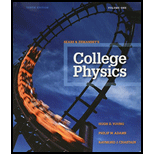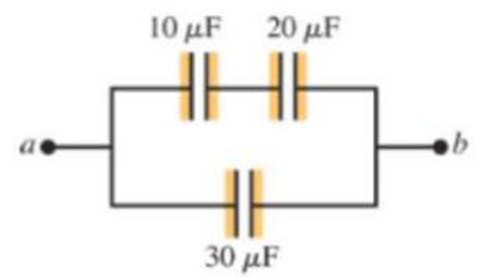
College Physics Volume 1 (Chs. 1-16); Mastering Physics with Pearson eText -- ValuePack Access Card -- for College Physics (10th Edition)
10th Edition
ISBN: 9780134151779
Author: Hugh D. Young, Philip W. Adams, Raymond Joseph Chastain
Publisher: PEARSON
expand_more
expand_more
format_list_bulleted
Concept explainers
Textbook Question
Chapter 18, Problem 3MCP
For the capacitor network shown in Figure 18.32, a constant potential difference of 50 V is maintained across points a and b by a battery. Which of the following statements about this network is correct? (There may be more than one correct choice.)

Figure 18.32
Multiple-Choice Problem 3.
- A. The 10 µF and 20 µF capacitors have equal charges.
- B. The charge on the 20 µF capacitor is twice the charge on the 10 µF capacitor.
- C. The potential difference across the 10 µF capacitor is the same as the potential difference across the 20 µF capacitor.
- D. The equivalent capacitance of the network is 60 µF.
Expert Solution & Answer
Want to see the full answer?
Check out a sample textbook solution
Students have asked these similar questions
Please solve and answer the question correctly please. Thank you!!
You throw a small rock straight up from the edge of a highway bridge that crosses a river. The rock passes you on its way down, 5.00 s after it was thrown. What is the speed of the rock just before it reaches the water 25.0 m below the point where the rock left your hand? Ignore air resistance.
Help me make a visualize experimental setup using a word document. For the theory below.
Chapter 18 Solutions
College Physics Volume 1 (Chs. 1-16); Mastering Physics with Pearson eText -- ValuePack Access Card -- for College Physics (10th Edition)
Ch. 18 - Why must electric field lines be perpendicular to...Ch. 18 - Which way do electric field lines point, from high...Ch. 18 - If the electric field is zero throughout a certain...Ch. 18 - The potential (relative to a point at infinity)...Ch. 18 - A capacitor is charged by being connected to a...Ch. 18 - A capacitor is charged by being connected to a...Ch. 18 - Two parallel-plate capacitors, identical except...Ch. 18 - The two plates of a capacitor are given charges Q,...Ch. 18 - Liquid dielectrics having polar molecules (such as...Ch. 18 - To store the maximum amount of energy in a...
Ch. 18 - You have two capacitors and want to connect them...Ch. 18 - You have three capacitors, not necessarily equal,...Ch. 18 - A surface will be an equipotential surface if...Ch. 18 - In Figure 18.31, point P is equidistant from both...Ch. 18 - For the capacitor network shown in Figure 18.32, a...Ch. 18 - Two charges are placed on the x axis. A charge of...Ch. 18 - Two point charges with charge +q are initially...Ch. 18 - If the potential (relative to infinity) due to a...Ch. 18 - If the electric potential energy of two point...Ch. 18 - An electron is released between the plates of a...Ch. 18 - The plates of a parallel-plate capacitor are...Ch. 18 - When a certain capacitor carries charge of...Ch. 18 - Two large metal plates carry equal and opposite...Ch. 18 - The electric potential (relative to infinity) due...Ch. 18 - A charge of 28.0 nC is placed in a uniform...Ch. 18 - Two very large charged parallel metal plates are...Ch. 18 - How far from a 7.20 C point charge must a +2.30 C...Ch. 18 - A point charge q1 = +2 40 C is held stationary at...Ch. 18 - Two stationary point charges of +3.00 nC and +2.00...Ch. 18 - A set of point charges is held in place at the...Ch. 18 - Three equal 1.20 C point charges are placed at the...Ch. 18 - When two point charges are a distance R apart,...Ch. 18 - Two large metal parallel plates carry opposite...Ch. 18 - A potential difference of 4.75 kV is established...Ch. 18 - BIO Axons. Neurons are the basic units of the...Ch. 18 - BIO Electrical sensitivity of sharks. Certain...Ch. 18 - A particle with a charge of +4 20 nC is in a...Ch. 18 - Two very large metal parallel plates are 20.0 cm...Ch. 18 - A uniform electric field has magnitude E and is...Ch. 18 - A point charge is sitting at the origin. The...Ch. 18 - An electron is to be accelerated from 3.00 108...Ch. 18 - A small particle has charge 5.00 C and mass 2.00 ...Ch. 18 - Two point charges q1 = +2.40 nC and q2 = 6.50 nC...Ch. 18 - A point charge Q = +4.00 C is held fixed al the...Ch. 18 - Two protons are released from rest when they are...Ch. 18 - x-ray tube. An x-ray tube is an evacuated glass...Ch. 18 - A parallel-plate capacitor having plates 6.0 cm...Ch. 18 - Two very large metal parallel plates that are 25...Ch. 18 - (a) A +5.00 C charge is located on a sheet of...Ch. 18 - A +1.50 C point charge is sitting at the origin....Ch. 18 - Dipole. A dipole is located on a sheet of paper....Ch. 18 - (a) You find that if you place charges of 1.25 C...Ch. 18 - The plates of a parallel-plate capacitor are 3.28...Ch. 18 - The plates of a parallel-plate capacitor are 2.50...Ch. 18 - A parallel-plate air capacitor has a capacitance...Ch. 18 - Suppose you were to design a 1 F parallel-plate...Ch. 18 - A 10.0 F parallel-plate capacitor with circular...Ch. 18 - A 10.0 F parallel-plate capacitor is connected to...Ch. 18 - You make a capacitor by cutting the...Ch. 18 - A 5.00 pF parallel-plate air-filled capacitor with...Ch. 18 - A disk-shaped parallel-plate capacitor has a...Ch. 18 - A parallel-plate capacitor C is charged up to a...Ch. 18 - For the system of capacitors shown in Figure...Ch. 18 - Electric eels. Electric eels and electric fish...Ch. 18 - In Figure 18.39, C1 = 6.00 f, C2 = 3.00 F. and C3...Ch. 18 - You are working on an electronics pro.ect that...Ch. 18 - In Figure 18 39, C1 = 3.00 F anri Vab = 120 V. The...Ch. 18 - A 4.00 F and a 6.00 F capacitor are wired in...Ch. 18 - In the circuit shown in Figure 18.40, the...Ch. 18 - In Figure 18.41 each capacitor has C = 4.00 f and...Ch. 18 - Figure 18.42 shows a system of four capacitors...Ch. 18 - For the system of capacitors shown in Figure...Ch. 18 - How much charge does a 12 V battery have to supply...Ch. 18 - A 5.80 F parallel-plate air capacitor has a plate...Ch. 18 - (a) How much charge does a battery have to supply...Ch. 18 - In the text, it was shown that the energy stored...Ch. 18 - A parallel-plate vacuum capacitor has 8.38 J of...Ch. 18 - A 5.00 nF parallel-plate capacitor contains 25.0 J...Ch. 18 - For the capacitor network shown in Figure 18.44,...Ch. 18 - For the capacitor network shown in Figure 18.45,...Ch. 18 - For the capacitor network shown in Figure 18.46,...Ch. 18 - A parallel-plate air capacitor has a capacitance...Ch. 18 - Cell membranes. Cell membranes (the walled...Ch. 18 - A parallel-plate capacitor is to be constructed by...Ch. 18 - A 12.5 F capacitor is connected to a power supply...Ch. 18 - The paper dielectric in a paper-and-foil capacitor...Ch. 18 - A constant potential difference of 12 V is...Ch. 18 - (a) If a spherical raindrop of radius 0.650 mm...Ch. 18 - At a certain distance from a point charge, the...Ch. 18 - Two oppositely charged identical insulating...Ch. 18 - A positive point charge Q is placed at a position...Ch. 18 - An alpha particle with a kinetic energy of 10.0...Ch. 18 - In the Bohr model of the hydrogen atom, a single...Ch. 18 - A proton and an alpha particle are released from...Ch. 18 - A parallel-plate air capacitor is made from two...Ch. 18 - In the previous problem, suppose the battery...Ch. 18 - A capacitor consists of two parallel plates, each...Ch. 18 - Electronic flash units for cameras contain a...Ch. 18 - In Figure 18.49, each capacitance C1 is 6.9 F and...Ch. 18 - Prob. 76PPCh. 18 - A helium ion (He++) that comes within about 10 fm...Ch. 18 - The maximum voltage at the center of a typical...Ch. 18 - How many moles of Na+ must move per unit area of...Ch. 18 - Prob. 80PPCh. 18 - Suppose that the change in Vm was caused by the...Ch. 18 - What is the minimum amount of work that must be...
Additional Science Textbook Solutions
Find more solutions based on key concepts
12. Figure Q25.12 shows two concentric, conducting loops. We will define a counterclockwise current (viewed fro...
College Physics: A Strategic Approach (3rd Edition)
How do food chains and food webs differ? Which is the more accurate representation of feeding relationships in ...
Biology: Life on Earth (11th Edition)
Distinguish between microevolution, speciation, and macroevolution.
Campbell Essential Biology (7th Edition)
3. What are serous membranes, and what are their functions?
Human Anatomy & Physiology (2nd Edition)
What type of unconformity separates layer G from layer F?
Applications and Investigations in Earth Science (9th Edition)
Explain why it is too narrow to define the biodiversity crisis as simply a loss of species.
Campbell Biology (11th Edition)
Knowledge Booster
Learn more about
Need a deep-dive on the concept behind this application? Look no further. Learn more about this topic, physics and related others by exploring similar questions and additional content below.Similar questions
- How to solve this, given answerarrow_forwardThree point-like charges are placed at the corners of a square as shown in the figure, 28.0 cm on each side. Find the minimum amount of work required by an external force to move the charge q1 to infinity. Let q1=-2.10 μC, q2=+2.40 μС, q3=+3.60 μC.arrow_forwardA point charge of -4.00 nC is at the origin, and a second point charge of 6.00 nC is on the x axis at x= 0.820 mm . Find the magnitude and direction of the electric field at each of the following points on the x axis. x2 = 19.0 cmarrow_forward
- Four point-like charges are placed as shown in the figure, three of them are at the corners and one at the center of a square, 36.0 cm on each side. What is the electric potential at the empty corner? Let q1=q3=+26.0 µС, q2=-28.0 μC, and q4=-48.0μc Varrow_forwardPLS HELparrow_forwardPlease solve and answer the question correctly please. Thank you!!arrow_forward
arrow_back_ios
SEE MORE QUESTIONS
arrow_forward_ios
Recommended textbooks for you
 Physics for Scientists and Engineers: Foundations...PhysicsISBN:9781133939146Author:Katz, Debora M.Publisher:Cengage Learning
Physics for Scientists and Engineers: Foundations...PhysicsISBN:9781133939146Author:Katz, Debora M.Publisher:Cengage Learning Principles of Physics: A Calculus-Based TextPhysicsISBN:9781133104261Author:Raymond A. Serway, John W. JewettPublisher:Cengage Learning
Principles of Physics: A Calculus-Based TextPhysicsISBN:9781133104261Author:Raymond A. Serway, John W. JewettPublisher:Cengage Learning College PhysicsPhysicsISBN:9781305952300Author:Raymond A. Serway, Chris VuillePublisher:Cengage Learning
College PhysicsPhysicsISBN:9781305952300Author:Raymond A. Serway, Chris VuillePublisher:Cengage Learning College PhysicsPhysicsISBN:9781285737027Author:Raymond A. Serway, Chris VuillePublisher:Cengage Learning
College PhysicsPhysicsISBN:9781285737027Author:Raymond A. Serway, Chris VuillePublisher:Cengage Learning Physics for Scientists and Engineers, Technology ...PhysicsISBN:9781305116399Author:Raymond A. Serway, John W. JewettPublisher:Cengage Learning
Physics for Scientists and Engineers, Technology ...PhysicsISBN:9781305116399Author:Raymond A. Serway, John W. JewettPublisher:Cengage Learning Physics for Scientists and Engineers with Modern ...PhysicsISBN:9781337553292Author:Raymond A. Serway, John W. JewettPublisher:Cengage Learning
Physics for Scientists and Engineers with Modern ...PhysicsISBN:9781337553292Author:Raymond A. Serway, John W. JewettPublisher:Cengage Learning

Physics for Scientists and Engineers: Foundations...
Physics
ISBN:9781133939146
Author:Katz, Debora M.
Publisher:Cengage Learning

Principles of Physics: A Calculus-Based Text
Physics
ISBN:9781133104261
Author:Raymond A. Serway, John W. Jewett
Publisher:Cengage Learning

College Physics
Physics
ISBN:9781305952300
Author:Raymond A. Serway, Chris Vuille
Publisher:Cengage Learning

College Physics
Physics
ISBN:9781285737027
Author:Raymond A. Serway, Chris Vuille
Publisher:Cengage Learning

Physics for Scientists and Engineers, Technology ...
Physics
ISBN:9781305116399
Author:Raymond A. Serway, John W. Jewett
Publisher:Cengage Learning

Physics for Scientists and Engineers with Modern ...
Physics
ISBN:9781337553292
Author:Raymond A. Serway, John W. Jewett
Publisher:Cengage Learning
Physics Capacitor & Capacitance part 7 (Parallel Plate capacitor) CBSE class 12; Author: LearnoHub - Class 11, 12;https://www.youtube.com/watch?v=JoW6UstbZ7Y;License: Standard YouTube License, CC-BY